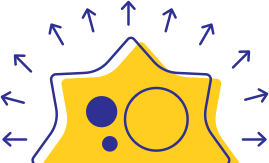Since it was first established in 2012, the CDCN has connected the global community of physicians, researchers, patients and loved ones to accelerate CD research, treatment, and patient care. The CDCN started by contacting all of the authors from the 2,000+ papers on PubMed associated with Castleman disease. Then, the CDCN held its first in-person meeting of physicians and researchers at ASH 2012 and webinars to connect the various members of the community. Next, the CDCN established an online forum for patients to connect with one another and an online forum for physicians and researchers to connect with one another.
The CDCN’s ground-breaking Collaborative Network Approach: an 8-step approach to accelerating research
-
Step 1
-
Step 2
-
Step 3
-
Step 4
-
Step 5
-
Step 6
-
Step 7
-
Step 8
Build Community
More recently, a database of the top physicians around the world was created to refer patients to them. This community is always growing, but today, it includes:
- A Scientific Advisory Board of 30 experts from eight countries on five continents
- 800+ physicians and researchers
- Over 10,000 patients and loved ones that have been connected through our online portal
- Patients are engaged on the Scientific Advisory Board, Leadership Team and research meetings, and supported through a Patient Summit, online discussion board, physician referrals, and educational materials.
Crowdsource and Prioritize Studies
The traditional way that rare disease research is performed is random, and it can be redundant and slow. Typically, research organizations raise funds, invite researchers to submit applications to use the funds how the researchers see fit, and the research organizations select the best applications to fund. One must hope that the right researcher with the right skill set submits an application with the right idea to perform the right project at the right time. The potential possibilities for what studies will be performed are limited to ideas generated by individuals who can actually perform the studies.
The CDCN takes a radically different approach. It leverages the Community (Step 1) of physicians, researchers, and patients to generate ideas for what studies should be done by using online questionnaires, a crowdsourcing platform (Codigital), social media data, and email submissions. Then, the CDCN Scientific Advisory Board prioritizes these crowdsourced ideas into an “International Research Agenda.”
Patients are at the heart of everything the CDCN does – by engaging patients on various platforms like the leadership team and online discussion board, the CDCN ensures the research priorities will answer questions most important to patients.
This approach means that we don’t just hope that the right study will be conceptualized and applied for by a researcher. We identify the right study and then recruit the right researcher (Step 3) with the right skill set to perform the study and provide the necessary funding and tissue samples. Most importantly, any idea can potentially turn into a study rather than just ideas conceived by the researchers that can perform the studies.
Identify Researchers
With the right studies identified and prioritized (Step 2) on the CDCN’s “International Research Agenda” (IRA, studies listed below), the CDCN actively recruits and engages the
leading expert for a particular kind of study to conduct the high-priority project that the CDCN needs performed. If you are a physician/researcher interested in getting involved, please join the network here.
Fundraise
With the right study identified and prioritized (Step 2) and the top researcher in the world recruited (Step 3), the CDCN performs targeted fundraising to enable the specific studies. The CDCN maximizes every dollar contributed by maintaining very low operating costs, promoting collaboration among researchers rather than duplication, and strategically funding high-impact research initiatives.
Funds are raised through four main channels:
- Events and campaigns (Quest for a Cure Gala!)
- Individual donations (donate here!)
- The Castleman Warrior Program – The Warrior program was established to connect patients and loved ones around the world. This very dedicated group of patients and loved ones fight back against CD by raising money and awareness for research. Get involved here!
- Collaborative partnerships with corporations and foundations
Enroll Patients and Procure Samples
For every study, the CDCN works with patients and physicians around the world to coordinate obtaining the necessary samples (e.g., blood, saliva, left over lymph node tissue, etc). Obtaining high-quality samples is a major challenge in rare disease research.
The CDCN proactively seeks to obtain tissue samples for future studies, because researchers can’t do research without patient samples. The CDCN’s international community of researchers needs samples from Castleman disease patients so that we can continue to drive forward our search for a cure! These samples help us to better characterize this disease and will lead to greater knowledge about current and potential treatments. If you would like to donate a sample, please click here!
Conduct Studies
After selecting the top priority project (Step 2), recruiting the foremost expert in that field (Step 3), and obtaining the necessary funds (Step 4) and samples (Step 5), the CDCN assists with all aspects of successful execution of the study.
We establish a research agreement, coordinate contracts among collaborators, provide project management support, and contribute scientific advice throughout the process.
Analyze data and search for new treatments based on results
After the data is generated from the study, the CDCN works with collaborators to ensure rapid analysis of the data. Together with the researcher and input from members of the CDCN research community, a paper is generated for a peer-reviewed journal that features the results of the study. Using results from research studies,
the CDCN aims to identify existing drugs that may be effective against Castleman disease. Results from the use of these existing treatments are captured in the ACCELERATE Patient Research Study. The CDCN also advances clinical trials of promising drugs based on these studies.
Disseminate Knowledge
After performing the studies and publishing the data, the CDCN works to ensure these findings are disseminated among researchers, physicians, patients and loved ones around the world as quickly as possible. We accomplish this through physician/researcher meetings, Patient Summits, online portals for patients, physicians and researchers, social media and online CDCN resources.
When battling a rare disease, it is essential new findings are shared with a wide audience as quickly as possible.
Then, the CDCN shares these results with the Community (Step 1) to inspire new ideas for research (Step 2) and the cycle repeats.









